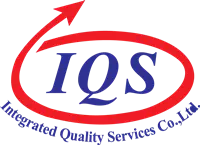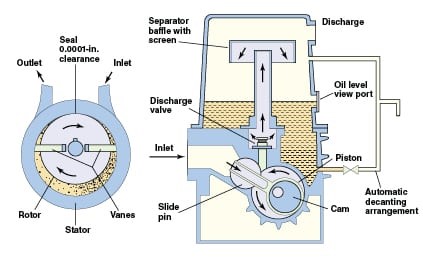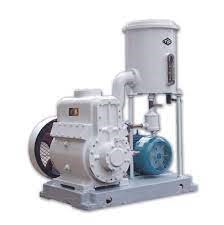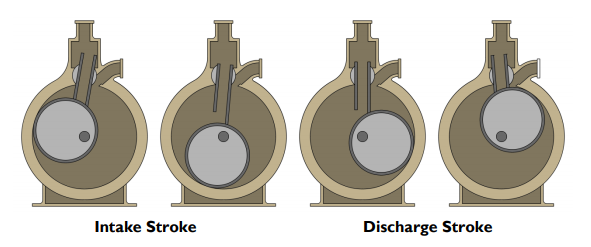Piston Vacuum Pump
คือปั๊มสุญญากาศแบบลูกสูบ (
1. แบบไม่ใช้น้ำมันในการหล่อลื่น (Oil free) ใช้ในการผลิตที่ไม่ต้องการให้มีน้ำมันหล่อลื่นเข้าไปปนเปื้อนในผลิตภัณฑ์ เช่นในอุตสาหกรรมผลิตอาหาร ผลิตยา เป็นต้น เพราะน้ำมันจะเป็นอันตรายต่อผู้บริโภค
2. แบบใช้น้ำมันในการหล่อลื่น (Oil lubricated)
โครงสร้างของ Rotary piston vacuum pump
Rotary Piston Vacuum Pumps
A rugged type of vacuum device is the rotary piston vacuum pump. Industries such as aerospace, vacuum degassing, evacuation, metal drying, and vacuum impregnation use the rotary piston vacuum pump to create vacuum. This type of pump is attractive when handling dry, non-condensable loads.
The piston is eccentric to the main bore of the pump cylinder. Gas is drawn into the chamber as the volume in the “bucket” expands as the piston moves around the chamber. When this volume is at its maximum, the bucket seals as the piston closes off the inlet port.
As the sealed-off gas rotates around the chamber, the gas is compressed and discharged out of the outlet port at a pressure slightly above atmospheric.
A thin film of lubricating oil lines the inside of the vacuum chamber within the rotary piston pump to achieve a better vacuum seal. However, this oil can become entrained in the process vapors and is present in the discharge vapors of the vacuum pump. Contaminated process gas is unavoidable.
The rotary piston pump has two configuration, single-stage and two-stage. Similar to liquid ring vacuum pumps, the two-stage configurations have higher capacities at deeper vacuum than the single-stage designs.
Additional components can be added to the rotary piston vacuum system to improve operability and convenience, including: oil mist eliminators to collect and recycle entrained oil, after-condensers and receivers to collect trace amounts of condensable on the discharge of the system, and many others.
ข้อดีและข้อเสียของ Rotary piston vacuum pump
Advantages:
- Relatively cheap and high capacity at deep vacuum levels (<0.01 Torr)
- Rugged design which allow for a long life
- Can allow trace amount of solvents
Limitations:
- Cannot handle liquids or any process carryover because these will damage the internals of the pump
- Cannot easily handle condensable vapors
- Solvent recovery is not possible due to oil contamination
Designs can be noisy
การใช้งาน (Application)
The rotary piston vacuum pump has become the major workhorse for a number of vacuum applications where relatively large chamber volumes have to be evacuated, where there is a large volume of outgassing from chamber walls or the process product or when the process has a high gas throughput due to gas being fed into the process chamber.
They are excellent if the process requires a vacuum range between a few mm Hg (also called torr after Mr. Torricelli) down to about 50 microns. The pumps are generally rated to give an ultimate vacuum of 10 microns. (1 micron = 1/1000th of 1 mm Hg) Remember that the vacuum level in the process chamber will always be higher than the ultimate or blank-off vacuum at the pump inlet.
Prior to the 1980s, when “dry” vacuum pumps started to enter the market, the rotary piston pump was a popular option when there was a large industrial or scientific process chamber to be evacuated. They were not used much in the chemical process industry, as the vacuum levels needed there were not as high and large volumes of gas and vapor could be handled better by steam ejectors combined with liquid ring type vacuum pumps. (A “dry” vacuum pump has no lubricant in the pumping volume, but still requires lubrication for gears and bearings.) Oil sealed rotary vane pumps, originally vee-belt driven and later mostly direct drive, were used but were not particularly suited to dirty applications, especially the faster running direct drive designs. In some applications with either a very harsh process or where the process requires a “cleaner” pump with less chance of contamination by oil vapor the newer designs of dry vacuum pumps have been used successfully.
In the heat treating and vacuum furnace industry rotary piston vacuum pumps are still an economical choice for many applications. The basic pumping capacity is often 150 cfm or 300 cfm and either size can be combined with a Roots design blower on the inlet side to give a variety of higher pumping speeds (and higher vacuum) depending on the pumping speed of the Roots blower. Also, the pumps are relatively easy to maintain or service by either in-house maintenance crews, local third-party service shops or by the pump manufacturer depending on the ability or choice of the user. A number of vacuum pump industry companies have the ability to manufacture and sell the basic piston, piston sleeve and hinge bars for this type of pump.
การเลือกใช้ปั๊มจะต้องกำหนดความดันและปริมาณการไหลที่ต้องการแล้ว การออกแบบ (Design) ตรงกับมาตรฐานอุตสาหกรรมที่ยอมรับ (Design code and standard เช่น ANSI, API, ISO, JIS, DIN, NFPA เป็นต้น) และคำแนะนำที่ยอมรับในการออกแบบปั๊มอุตสาหกรรม (Industrial practices) ชนิดนั้นๆ
บริษัทไอคิวเอสเป็นตัวแทนจำหน่ายและบริการของ Woosung vacuum pump ที่มีชื่อเสียงในการผลิต Vacuum pump จากประเทศเกาหลี มีใช้กันแพร่หลายในบริษัทชั้นนำทั่วโลก มีสินค้าหลายชนิด หลายขนาด (Wide range) ครอบคลุมการใช้งาน (Application) มีสินค้าให้เลือกใช้ตามความเหมาะสมกับการใช้งาน ในอุตสาหกรรมเกือบทุกชนิด
นอกจาก Woosung ยังผลิต Vane vacuum pump, Dry screw vacuum pump, และ Vacuum system accessories อีกด้วย
นอกจากนี้บริษัทไอดีลยังรับผิดชอบในบริการหลังการขาย เพื่อให้ลูกค้าสบายใจในการเลือกใช้ปั๊ม Woosung
บริษัทไอคิวเอส มีวิศวกรที่มีความชำนาญ ในการเลือกชนิด(Type) ขนาด (Size) และกำลัง (Rating) ของปั๊มให้เหมาะสมกับงานนั้นๆ โดยได้รับการสนับสนุนด้านเทคนิคจากบริษัทผู้ผลิตปั๊ม สามารถให้คำปรึกษาแก่ลูกค้าได้ตลอดเวลา
สนใจติดต่อ ขอคำปรึกษา ติดต่อ บ. อินทีเกรทเต็ด ควอลิตี้ เซอร์วิสเซส จำกัด



